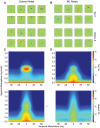Noise-invariant neurons in the avian auditory cortex: hearing the song in noise
- PMID: 23505354
- PMCID: PMC3591274
- DOI: 10.1371/journal.pcbi.1002942
Noise-invariant neurons in the avian auditory cortex: hearing the song in noise
Abstract
Given the extraordinary ability of humans and animals to recognize communication signals over a background of noise, describing noise invariant neural responses is critical not only to pinpoint the brain regions that are mediating our robust perceptions but also to understand the neural computations that are performing these tasks and the underlying circuitry. Although invariant neural responses, such as rotation-invariant face cells, are well described in the visual system, high-level auditory neurons that can represent the same behaviorally relevant signal in a range of listening conditions have yet to be discovered. Here we found neurons in a secondary area of the avian auditory cortex that exhibit noise-invariant responses in the sense that they responded with similar spike patterns to song stimuli presented in silence and over a background of naturalistic noise. By characterizing the neurons' tuning in terms of their responses to modulations in the temporal and spectral envelope of the sound, we then show that noise invariance is partly achieved by selectively responding to long sounds with sharp spectral structure. Finally, to demonstrate that such computations could explain noise invariance, we designed a biologically inspired noise-filtering algorithm that can be used to separate song or speech from noise. This novel noise-filtering method performs as well as other state-of-the-art de-noising algorithms and could be used in clinical or consumer oriented applications. Our biologically inspired model also shows how high-level noise-invariant responses could be created from neural responses typically found in primary auditory cortex.
Conflict of interest statement
The authors have declared that no competing interests exist.
Figures







References
-
- Rauschecker JP, Tian B, Hauser M (1995) Processing of complex sounds in the macaque nonprimary auditory cortex. Science 268: 111–114. - PubMed
Publication types
MeSH terms
Grants and funding
LinkOut - more resources
Full Text Sources
Other Literature Sources

